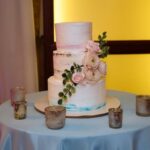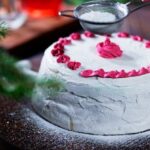Are you a beginner looking to learn how to decorate a cake with royal icing? Look no further. In this article, we will provide you with a step-by-step guide on how to use royal icing to create beautiful and professional-looking cake decorations.
Royal icing is a popular choice for cake decorating because of its versatility and ability to create intricate designs. It dries to a smooth, hard finish, making it perfect for piping intricate details and creating 3D effects on cakes. Whether you’re looking to make simple designs or more elaborate creations, royal icing is an excellent option for beginners and experienced decorators alike.
Before we dive into the step-by-step guide, we will discuss the essential tools and ingredients you need for decorating a cake with royal icing. From piping bags and tips to the right consistency of icing, having the necessary supplies at your disposal will set you up for success in your cake decorating journey. So, let’s get started on this sweet adventure of learning how to decorate a cake with royal icing.
Essential Tools and Ingredients for Decorating a Cake With Royal Icing
When it comes to decorating a cake with royal icing, having the right tools and ingredients is essential for achieving professional-looking results. Some of the essential tools for working with royal icing include piping bags, piping tips in various sizes and shapes, an offset spatula for smoothing the icing, and a turntable for easy maneuvering while decorating.
In addition to these tools, having the right ingredients is just as important. To make royal icing, you will need egg whites or meringue powder, powdered sugar, and flavoring extracts such as vanilla or almond.
Piping bags are a must-have tool for applying royal icing to your cake. Disposable piping bags are convenient and make cleanup easier, but reusable silicone piping bags are also a popular choice among bakers.
Piping tips come in a variety of shapes and sizes, each creating different decorative effects. As a beginner, it’s recommended to have a selection of round tips for outlining and flooding, as well as star tips for creating borders and adding texture to your designs.
In addition to the basic tools, having the right ingredients is crucial for making royal icing that is easy to work with and yields professional results. Powdered sugar is the main ingredient in royal icing, while egg whites or meringue powder act as the stabilizer to give the icing its smooth consistency.
It’s important to use high-quality ingredients to ensure that your royal icing sets properly and has a smooth texture when piped onto the cake. By having these essential tools and ingredients on hand, beginners can start their royal icing decorating journey with confidence.
Step-by-Step Guide on How to Prepare and Color Royal Icing
To prepare and color royal icing for cake decorating, you will need a few essential tools and ingredients. The key tools include a stand mixer or hand mixer, mixing bowls, rubber spatula, piping bags, piping tips, and food coloring. The main ingredients for royal icing are powdered sugar (also known as confectioners’ sugar), meringue powder or egg whites, and water.
Preparing the Royal Icing
Begin by sifting the powdered sugar to remove any lumps that could cause clumps in your icing. In a clean mixing bowl, combine the sifted powdered sugar with meringue powder or egg whites. Gradually add water while mixing until the icing reaches the desired consistency. For outlining and detailed work, a thicker consistency is needed, while flooding requires a thinner consistency.
Coloring the Royal Icing
After preparing the base royal icing, it’s time to add color. Gel food coloring is recommended as it won’t water down the icing like liquid food coloring would. Start with small amounts of gel color and mix well to achieve your desired shade. Keep in mind that royal icing tends to darken slightly as it dries, so aim for a slightly lighter shade than what you ultimately want.
Storing Royal Icing
If you’re not using all of the prepared royal icing at once or if you have leftovers after decorating your cake, store it properly to prevent it from drying out. Transfer any unused royal icing to an airtight container and cover its surface with plastic wrap directly touching the icing before sealing the container. This helps prevent exposure to air that can cause crusting. Stored at room temperature away from direct sunlight, royal icing can last for several days.
By following these step-by-step instructions for preparing and coloring royal icing, beginners can feel more confident in creating beautiful designs on their cakes. Experimenting with different consistencies and colors will also help improve your skills in handling this popular cake decorating medium.
Preparing the Cake for Icing
The next essential step is crumb coating, which involves applying a thin layer of royal icing to seal in any loose crumbs on the surface of the cake. This initial layer also helps to create a smooth base for the final coat of icing. Use an offset spatula to spread a thin layer of royal icing over the entire cake, ensuring that all sides are evenly coated.
After crumb coating, it is time to apply a smooth base layer of royal icing. Start by adding a generous amount of royal icing on top of the cake, then use an offset spatula to spread it evenly across the surface and down the sides. Work quickly but carefully to achieve a uniform finish. Once the entire cake is covered with a smooth layer of royal icing, you can proceed with your chosen decorating techniques.
By properly preparing the cake for icing through leveling, crumb coating, and applying a smooth base layer, beginners can ensure that their royal icing decorations will be visually appealing and long-lasting. These essential steps set the stage for successful cake decorating and provide beginners with a solid foundation for honing their skills in working with royal icing.
Basic Royal Icing Techniques for Beginners
When it comes to decorating a cake with royal icing, beginners should start with the basic techniques of outlining, flooding, and marbling. These techniques are the foundation for creating beautiful designs and patterns on cakes and can be easily mastered with practice.
Outlining involves using a thicker consistency of royal icing to create borders or outlines on the cake. This provides a clear structure for the design and prevents the flooded icing from spilling over the edges. Flooding, on the other hand, requires a thinner consistency of royal icing that can be easily spread over the outlined areas.
This creates a smooth and even surface for decorating. Lastly, marbling is a beginner-friendly technique that involves swirling two or more colors of icing together to create a unique marbled effect.
To achieve these basic royal icing techniques, beginners will need piping bags, piping tips (such as round tips for outlining and flooding, and star tips for marbling), gel food coloring for tinting the icing, and practice boards or parchment paper for testing out designs before applying them to the cake.
It’s important for beginners to remember that precision and patience are key when working with royal icing. Taking the time to practice these basic techniques will ultimately lead to more intricate designs as skills improve.
| Royal Icing Technique | Description |
|---|---|
| Outlining | Using thicker icing to create borders or outlines on the cake |
| Flooding | Using thinner icing to spread over outlined areas for a smooth surface |
| Marbling | Swirling two or more colors of icing together for a unique marbled effect |
Advanced Royal Icing Techniques
Once you’ve mastered the basic royal icing techniques of outlining, flooding, and marbling, you can move on to more advanced skills such as piping flowers, creating intricate designs, and adding texture to your cake decorations. These techniques require a steady hand and some practice, but they can elevate your cake decorating to a professional level.
Piping flowers with royal icing can create beautiful and delicate embellishments for your cake. You can use a variety of piping tips to create different types of flowers, from roses to daisies to lilies. By practicing pressure control and experimenting with different techniques, you can add stunning floral accents to your cake that will impress your friends and family.
Creating intricate designs with royal icing opens up a world of possibilities for cake decorating. From lace-like patterns to intricate filigree designs, royal icing allows you to add fine details and embellishments that can make your cake truly stand out. With patience and a steady hand, you can use piping bags and fine tips to create stunning designs that look like they were done by a professional baker.
Adding texture to your royal icing decorations can take your cake decorating to the next level. By using different tools such as combs or brushes, you can create unique textures on the surface of your icing that will give your decorations depth and interest. With some experimentation, you can find creative ways to add texture that will make your cake visually appealing and memorable.
| Technique | Description |
|---|---|
| Piping Flowers | Create delicate floral embellishments using piping tips |
| Intricate Designs | Add fine details and patterns using piping bags and fine tips |
| Adding Texture | Create unique textures using tools such as combs or brushes |
Troubleshooting Common Royal Icing Issues and How to Fix Them
Issue: Royal Icing Is Too Runny
If your royal icing is too runny, it may be due to adding too much water when initially mixing the icing. To fix this issue, add more sifted powdered sugar to thicken the consistency. Start by adding small amounts at a time until you achieve the desired texture. You can also mix in a small amount of meringue powder to help stabilize and thicken the icing.
Issue: Craters or Pits in the Icing
If you notice craters or pits forming in your royal icing after it has dried, it could be due to air bubbles trapped in the icing while decorating. To prevent this, use a toothpick or scribe tool to gently pop any air bubbles that form on the surface of the icing as you work. Additionally, tapping the cake on a flat surface can help smooth out any imperfections before the icing sets.
Issue: Icing Cracks or Separates
If your royal icing is cracking or separating as it dries, it may be because it was applied too thinly. To avoid this issue, make sure that each layer of icing is thick enough to provide ample coverage without being too heavy. Layering additional coats of thicker consistency royal icing can help create a smooth and seamless finish.
By recognizing these common issues and knowing how to address them, you can confidently troubleshoot any problems that may arise when decorating a cake with royal icing. With practice and patience, you’ll soon master the art of working with royal icing to create beautifully decorated cakes.
Tips and Tricks for Creating a Professional-Looking Cake With Royal Icing
Decorating a cake with royal icing can seem daunting for beginners, but with the right tips and tricks, you can create a professional-looking masterpiece. Here are some helpful guidelines to achieve stunning results:
- Use the right consistency: The key to achieving a smooth finish with royal icing is to ensure that it is the right consistency. For outlining and piping details, the icing should be thick and hold its shape. For flooding and covering larger areas, the icing should be thin enough to spread easily.
- Practice proper pressure control: When piping intricate designs or creating delicate details, it’s crucial to have control over the pressure applied to the piping bag. Practice on parchment paper or a practice board before decorating the actual cake to get a feel for the right amount of pressure needed.
- Work efficiently: Royal icing tends to dry quickly, so it’s important to work efficiently when decorating your cake. Have all your tools and colors ready before you start, and avoid taking breaks in between decorating different sections of the cake to maintain a seamless finish.
In addition to these tips, there are also some tricks that can take your royal icing cake decoration to the next level:
- Embrace texture: Experiment with different techniques to add texture to your royal icing decorations, such as using a toothpick to create swirls or patterns in flooded areas, or gently tapping the surface with a small brush for a subtle textured effect.
- Add dimension with layering: To create more visual interest and depth in your designs, consider layering different colors or adding additional piped elements on top of flooded areas once they have dried. This can create beautiful three-dimensional effects on your cake.
- Finishing touches matter: Pay attention to small finishing touches such as adding edible metallic accents or dusting with edible glitter. These little details can elevate the overall look of your decorated cake and give it a polished, professional appearance.
By keeping these tips and tricks in mind, you’ll be well on your way to creating stunning cakes with royal icing that will impress family and friends alike. Don’t be afraid to experiment and practice – after all, practice makes perfect.
Conclusion
In conclusion, decorating a cake with royal icing can be a fun and rewarding experience for beginners. As discussed in this article, royal icing offers versatility and allows for a wide range of decorative techniques, making it a popular choice among bakers and decorators. By following the step-by-step guide and using essential tools and ingredients, beginners can start mastering basic and advanced royal icing techniques to create stunning cakes.
It is important for beginners to remember that practice makes perfect when it comes to decorating with royal icing. Experimenting with different piping tips, colors, and designs will help improve skills and creativity. While it may seem daunting at first, troubleshooting common issues such as consistency and air bubbles will only make decorators more experienced in working with royal icing.
Ultimately, the key to success in decorating a cake with royal icing lies in patience and perseverance. With dedication and a willingness to learn from mistakes, beginners can achieve professional-looking results. So don’t be afraid to unleash your creativity and let your imagination run wild – the possibilities are endless when it comes to decorating with royal icing.
Frequently Asked Questions
Can I Put Royal Icing Directly on a Cake?
Putting royal icing directly on a cake is usually not recommended. Royal icing tends to dry very hard, which can make it difficult to cut and eat the cake. It’s best to use royal icing for decorative details like piping or flowers rather than covering the entire cake with it.
How Do You Use Royal Icing for Beginners?
For beginners, using royal icing can be a bit tricky but with some practice, it becomes easier. The key is to make sure the icing is at the right consistency – not too runny and not too stiff. Beginners should start by practicing basic piping techniques on a flat surface before moving on to more intricate designs on cakes or cookies.
How Do You Smooth Out Royal Icing on a Cake?
Smoothing out royal icing on a cake requires patience and a steady hand. One method is to use an offset spatula to gently spread the icing in an even layer across the cake, being careful not to apply too much pressure that could create air bubbles or break the surface of the icing.
Another technique involves using a Viva paper towel or parchment paper to gently smooth out the surface of the royal icing once it has crusted over, resulting in a clean and polished finish.

Welcome to my blog about home and family. This blog is a place where I will share my thoughts, ideas, and experiences related to these important topics. I am a stay-at-home mom with two young children. I hope you enjoy reading it! and may find some helpful tips and ideas that will make your home and family life even better!





